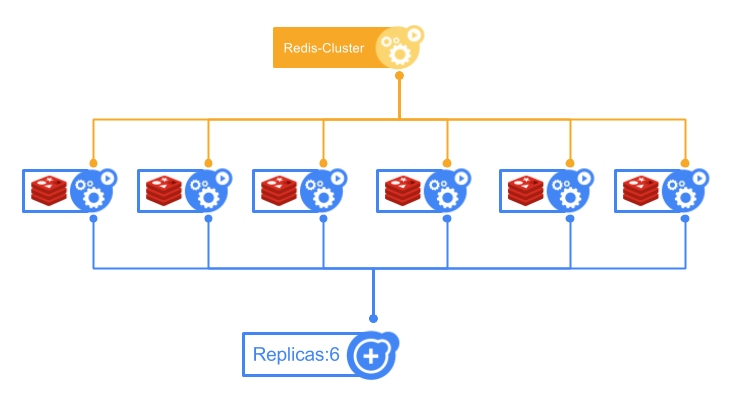This is an ongoing project.
The aim of this project is to ease the deployment and operations of a Redis-cluster in a kubernetes environment. It started internally at Amadeus in 2016, we initially designed this project to run on Openshift. This is the second version of our Redis-Operator that is based now on Kubernetes CustomResourceDefinition (CRD) for representing the RedisCluster configuration.
The Redis-cluster will be deployed thanks to a unique deployment. Each node of the Redis-cluster is running in its own Pod; At startup, each node has no active role (not slave nor master with slot), it just joins the cluster as a master without slot. See representation in the schema below
At this point you have your redis process running, each node is aware of each other, but only one master prossess all slots.
In order to configure properly the different redis-servers and setup the redis cluster, we introduce the Redis-Operator.
The redis-operator is watching a new kind of Custom-Resource RedisCluster that stores the redis-cluster configuration: number of masters, and the replication factor (number of slaves by master) and the pod template. Then the redis-operator tries to apply this configuration to the set of redis-server processes. If the number of redis-servers doesn't correspond to the provided configuration, the manager scales the redis-node pods to obtain the proper number of redis-nodes.
Then reconciliation is constantly done between the state of the cluster and the configuration stored in the RedisCluster CR.
If you want to take part of the development, you can follow the document: CONTRIBUTING.md.
you can found checkt the docs/cookbook.md that is a step by step commands cookbook to test/demo the deployment of the operator and a redis-cluster with minikube.
As said, the project was initially designed to works on Openshift, but now support also Kubernetes. Please check the minimum environment version in the table below.
| Environment | Version |
|---|---|
| Openshift | >= 3.7 |
| Kubernetes | >= 1.7 |
You can found in the charts folder two helm charts:
redis-operator: used to deploy theredis-operatorinto your kubernetes cluster.redis-cluster: used to create a "Redis Cluster" instance thanks to theredis-operator.
helm install --name op charts/redis-operator
NAME: op
LAST DEPLOYED: Tue Jan 9 23:41:13 2018
NAMESPACE: default
STATUS: DEPLOYED
RESOURCES:
==> v1beta1/Deployment
NAME DESIRED CURRENT UP-TO-DATE AVAILABLE AGE
op-redis-operator 1 1 1 0 0sTODO: document RBAC support.
Thanks to the helm chart chart/redis-cluster you can create a RedisCluster Custom Resource which will be processed by the redis-operator.
You can configure the Topology of the cluster by providing your own values.yml file to helm, or settings the value with the --set parameters when you execute helm install
helm install --name mycluster charts/redis-cluster --set numberOfMaster=3 --set replicationFactor=1
...! Warning !, if you want to use the docker images corresponding to the level of code present in the "master" branch. you need to set the image tag when you instanciate the Redis-Cluster chart and the Redis-Operator chart. The "latest" tag is corresponding to the last validated release.
helm install --name mycluster chart/redis-cluster --set image.tag=master --set numberOfMaster=3 --set replicationFactor=1
...docs available here.
cd $GOPATH/src/github.com/amadeusitgroup/redis-operator
make container
CGO_ENABLED=0 GOOS=linux go build -i -installsuffix cgo -ldflags '-w' -o docker/operator/operator ./cmd/operator/main.go
CGO_ENABLED=0 GOOS=linux go build -i -installsuffix cgo -ldflags '-w' -o docker/redisnode/redisnode ./cmd/redisnode/main.goyou can define the docker images tag by adding the variable "VERSION"
make TAG=<Your-TAG> containerpublish the docker images in your docker registry
make TAG=<Your-TAG> publishIn addition to the version, you can also specify the docker registry where will be publish the docker images with the variable DOCKER_REGISTRY
make DOCKER_REGISTRY="mydockerregistry:5000/" TAG=<Your-TAG> publishThis project is using goreleaser and an additional script for releasing also the Helm chart.
For starting the delivery, you need to clone this repository, then:
zsh hack/release.sh <version> <remove-git>a concreate example is: zsh ./hack/release.sh v1.0.1 upstream
This script:
- generates locally the helm chart with the requested version.
- updates the helm repo index file (
docs/index.yaml) file with the new release. - creates a new changeset with all changes generated by the new release version, then tag this changeset.
- push changeset and associated tag to the remote git repository.

